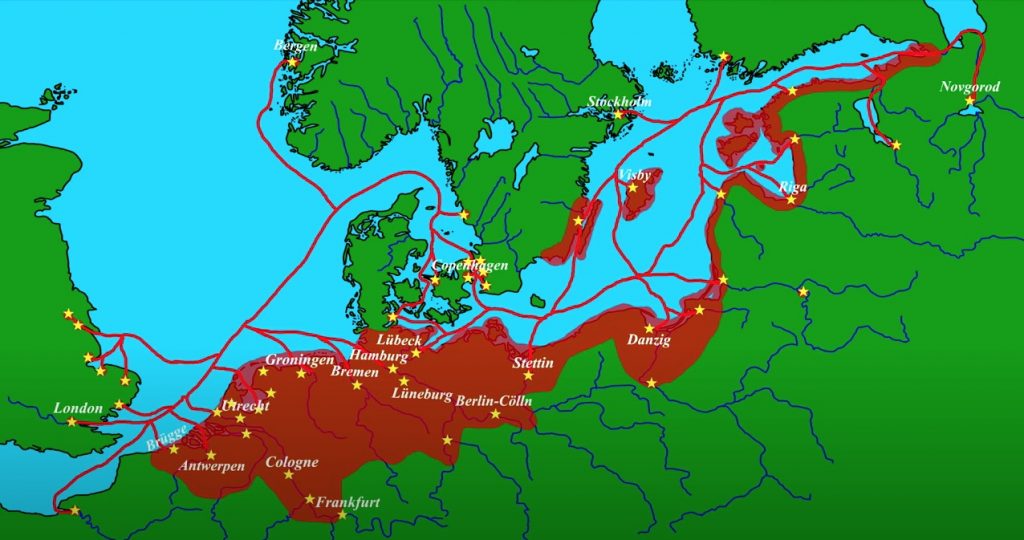What was the Hanseatic League?
The Hanseatic League was an organization founded by the Northern European Baltic and German trading towns and cities to protect their mutual trading interests and their trading communities abroad. (Hanse was a medieval German word for “guild” or “association”.) The wealth in the area had grown following the cessation of Viking raids in the mid-C11th and German merchants were the first to exploit this, migrating northwards and establishing guilds and trading towns.
The League was most active between C12th – C16th, and grew to include bases in England, Scandinavia, and Russia. It was officially called the Hanseatic League in 1356 and it was finally formally dissolved in 1862 after the growth of national trading companies. The earliest activity centred on Lübeck. The main bases in England were in London, Boston, King’s Lynn, and Hull. Lynn had strong links with Danzig (modern day Gdansk). The League was re-established as a Cultural Group in 1980.

A Common Market Plus
The aims of the league were clear: safety at sea, secure bases, favourable trade, monopolies. Crime in the Middle Ages was rampant owing to the various governments’ inability – or unwillingness – to apprehend and prosecute criminals. The overriding purpose of many of the associations, and one which always remained, was to enable combined action against pirates (see this in action – Hanseatic League and King’s Lynn 1 of 3). Effort was also put into the provision of lighthouses, marker buoys, trained pilots, and other aids to safe navigation.
League members also sought to establish secure bases for trade. They usually asked permission to build a base either just outside, or inside a city wall. At the time this sometimes involved a big concession (as in King’s Lynn in 1474) as often visiting merchants were forced to stay in lodgings.
League members established favourable conditions for trade. Members were often exempt from local trading laws and the League effectively established a free trading area for member cities. The League could be also used as an instrument for establishing a monopoly in those branches of trade and in those areas where it was firmly established.
Hanseatic merchants would arrive in new trading town, assess the value of goods in the area, examine the trade routes possible from the area, and then seek permission to establish a settlement. Each outpost was known as a ‘kontor’, meaning an ‘office’. Members corporately owned a large complex of houses, halls, warehouses, and other buildings from where they traded with the local population. They jointly operated from ‘steelyards’.
The Hanseatic power came from the fact that it delivered goods from the east that ports in the west wanted, and therefore gave its merchants considerable economic leverage. Grain, timber and pitch, tar, potash and charcoal, wax and honey, and hemp and flax all were drawn from the huge hinterland to the south and east of the Baltic (modern-day Russia and Poland) and shipped to the industrial west (Flanders and England), which in turn sent cloth and other manufactured goods eastward.
Why did trade disputes miles away at sea end up leaving such a mark on a Norfolk Market Town?
What happened to the Hanseatic Buildings in King’s Lynn after 1474?
© James Rye 2021
Book a Walk with a Trained and Qualified King’s Lynn Guide Through Historic Lynn.
Sources
- Friedland, K. & Richards, P. (eds) (2005) Essays in Hanseatic History: The King’s Lynn Symposium 1988, Larks Press
- Hillen, H.J. (1907) History of the Borough of King’s Lynn, Vol.1, EP Publishing Ltd.
- Kleineke, H. (Accessed June 2021) A Letter Relating To The Crisis of 1468, Published online at http://www.thericardian.online/downloads/Ricardian/20/06.pdf
- Richards, P. (2022) King’s Lynn and the German Hanse 1250-1550, Poppyland Publishing
Websites all accessed June 2021:
- https://de.zxc.wiki/wiki/Stalhof
- https://www.britannica.com/topic/Hanseatic-League/The-League-at-its-outset
- https://www.visitwestnorfolk.com/places/kings-lynn/history-of-kings-lynn/hanseatic-kings-lynn/
- https://en.wikipedia.org/wiki/Hanseatic_League
- https://www.ancient-origins.net/ancient-places-europe/hanseatic-league-0013886
- https://podcasts.apple.com/gb/podcast/gone-medieval/id1564113746?i=1000587050034

[…] Hanseatic League and King’s Lynn (2 of 2) […]
[…] What was the Hanseatic League? […]
[…] East Coast also meant that it was perfectly suited to trade with the thriving Baltic Region and the Hanseatic […]
[…] from Flanders. His fleet comprised 36 ships. Ironically 15 of those ships were hired from the Hanseatic League on the promise of favourable concessions to the League if Edward succeeded in regaining […]